Tom's Guide Verdict
Smack in the middle of Motorola's lineup, the Razr Plus (2025) is a puzzling option given how it doesn't get much major hardware upgrades from last year's model. It performs almost identically to the previous version, while introducing Moto AI features. All of this makes it a tougher sell especially compared with the bigger gains of the Razr Ultra (2025).
Pros
- +
Stylish design and color options
- +
Bright main display
- +
Strong camera performance
- +
Useful Moto AI features
Cons
- -
No major hardware changes
- -
Battery could be better
- -
Could use more AI features
Why you can trust Tom's Guide
For the last few years, the Plus has been Motorola’s premier foldable phone in its lineup. In fact, the Razr Plus (2023) proved that Motorola’s flip-style phones could be superior to Samsung's. But this year’s a different story, as the Razr Ultra (2025) supplants the Plus in being the top model.
I’ve said a lot of good things about it in my Razr Ultra (2025) review, like its class-leading battery life and processing performance. While those are great attributes in any best phone contender, its higher price point makes it a tougher sell — which is why it’s worth looking at the Motorola Razr Plus (2025).
The Razr Plus is in the middle of Moto's lineup with a starting price tag of $999. It's $300 less than the Razr Ultra (2025). At the same time, though, it appears to share a lot of qualities with its predecessor. For example, it’s powered by the same Snapdragon 8s Gen 3 chip and packs a 4,000 mAh battery.
Is it really any different from last year’s model? I’ll tell you in my Razr Plus (2025) review, along with how it stacks up against the Ultra.
Motorola Razr Plus (2025) review: Specifications
Motorola Razr Plus (2025) | Motorola Razr Ultra (2025) | Motorola Razr Plus (2024) | |
Price | $999.99 | $1,299.99 | $999 |
Colors | Pantone Mocha Mousse, Midnight Blue, and Hot Pink | Pantone Rio Red, Pantone Scarab, Pantone Mountain Trail, and Pantone Cabaret | Midnight Blue, Spring Green, Peach Fuzz, Hot Pink |
Inner display | 6.9-inch FHD+ (2640 x 1080) pOLED, up to 165 Hz | 7-inch AMOLED, up to 165 Hz | 6.9-inch FHD+ (2640 x 1080) pOLED, up to 165 Hz |
Outer display | 4-inch pOLED, up to 165 Hz | 4-inch pOLED, up to 165 Hz | 4-inch pOLED (1272 x 1080), up to 165 Hz |
Rear camera | 50MP main (f/1.7), 50MP telephoto (f/2) with 2x optical zoom | 50MP main (f/1.8), 50MP ultrawide (f/2) | 50MP main (f/1.7), 50MP telephoto (f/2.2) with 2x optical zoom |
Front camera | 32MP (f/2.4) | 50MP (f/2) | 32MP (f/2.4) |
Chipset | Snapdragon 8s Gen 3 | Snapdragon 8 Elite | Snapdragon 8s Gen 3 |
RAM | 12GB | 16GB | 12GB |
Storage | 256GB | 512GB | 256GB |
Battery | 4,000 mAh | 4,700 mAh | 4,000 mAh |
Wired charging | 45W | 68W | 45W |
Wireless charging | 15W | 30W | 15W |
Dimensions | 2.91 x 6.74 x 0.27 inches (open), 2.91 x 3.47 x 0.60 inches (closed) | 2.91 x 6.75 x 0.28 inches (open), 2.91 x 3.47 x 0.62 inches (closed) | 6.74 x 2.91 x 0.27 inches (open), 3.46 x 2.91 x 0.6 inches (closed) |
Weight | 6.67 ounces | 7.02 ounces | 6.66 ounces |
Motorola Razr Plus (2025) review: Price and release
The Motorola Razr Plus (2025) launched on May 15 alongside the company’s other two foldable phones, the Razr (2025) and Razr Ultra (2025), at a price of $999. This makes it $300 less than the Ultra and $300 more than the standard Razr (2025), so it boils down to whether or not the $300 difference makes it worth it. Again, that’s something I’ll detail throughout this Razr Plus (2025) review.
Similar to last year’s model, it comes with 256GB storage and 12GB of RAM — and comes in three different colors: Pantone Mocha Mousse, Midnight Blue, and Hot Pink.
Motorola Razr Plus (2025) review: Design

Apart from the new color options, there isn’t much difference with the design of the Razr Plus (2025). I still love its stylish cues, like its rounded edges and vibrant color tones. The Pantone Mocha Mousse has a strong contrast with its textured back casing and the more metallic looking frame.
Get instant access to breaking news, the hottest reviews, great deals and helpful tips.

Compared to the Ultra, the Plus is a smidge thinner and lighter, while evoking the same premium construction. Opening and closing it is met with the same snappy response, thanks in part to a new titanium-reinforced hinge plate. And unlike Samsung’s design with the Galaxy Z Flip 7, I can confidently flip it open without hassle or worry. Considering how it’s $300 less than the Ultra, it’s swell that the Razr Plus (2025) gets the same level of treatment with its design.
Motorola Razr Plus (2025) review: Display
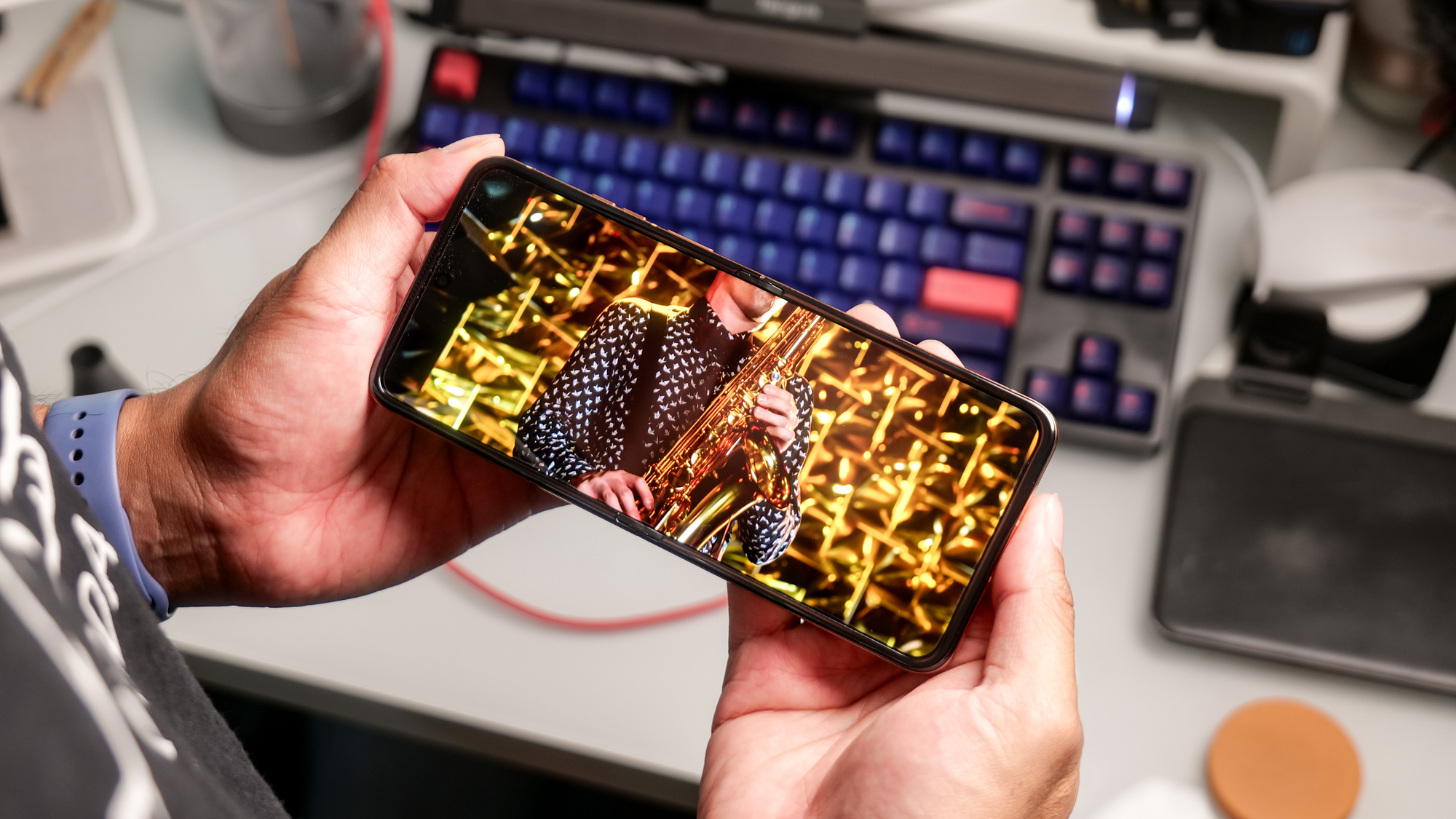
Given how it’s had a winning recipe, I’m not surprised there’s no size change to the displays. On the outside, the same sprawling 4-inch pOLED display from before still goes nearly to the edges. I really love the extra utility it offers, mainly for the fact that it can run full apps, can auto rotate, and makes it a breeze to use the phone one-handed.
Meanwhile, its main 6.9-inch pOLED display continues to look stunning. I find it delightful for just about everything, including the occasional gaming session and whenever I can sneak in a show on Netflix. Everything it shows looks stunning thanks to its punchy color tones, outstanding viewing angles, and its blinding brightness.
| Row 0 - Cell 0 | Motorola Razr Plus (2025) | Motorola Razr Ultra (2025) | Motorola Razr Plus (2024) |
Screen size | 6.9 inches | 7 inches | 6.9 inches |
Brightness (nits) | 2,144 | 1,835 | 2,158 |
sRGB % | 69.7 (Natural) | 214.3 (Vivid), 123.2 (Natural) | 98.1% (Natural) |
DCI-P3 % | 49.3 (Natural) | 151.8 (Vivid) / 123.2 (Natural) | 69.5% (Natural) |
Delta-E score (closer to zero is better) | 0.24 (Natural) | 0.33 (Vivid) / 0.26 (Natural) | 0.23 (Natural) |
In Tom’s Guide’s display benchmark test, the main display reaches an astounding peak brightness of 2,144 nits. This is noteworthy because very few phones can reach this, making it brighter than the Razr Ultra (2025) and Galaxy Z Flip 7. However, it comes up just a teeny tiny short against the Razr Plus (2024). I’m not bummed at all because it’s still incredibly bright by today’s standards.
Motorola Razr Plus (2025) review: Cameras
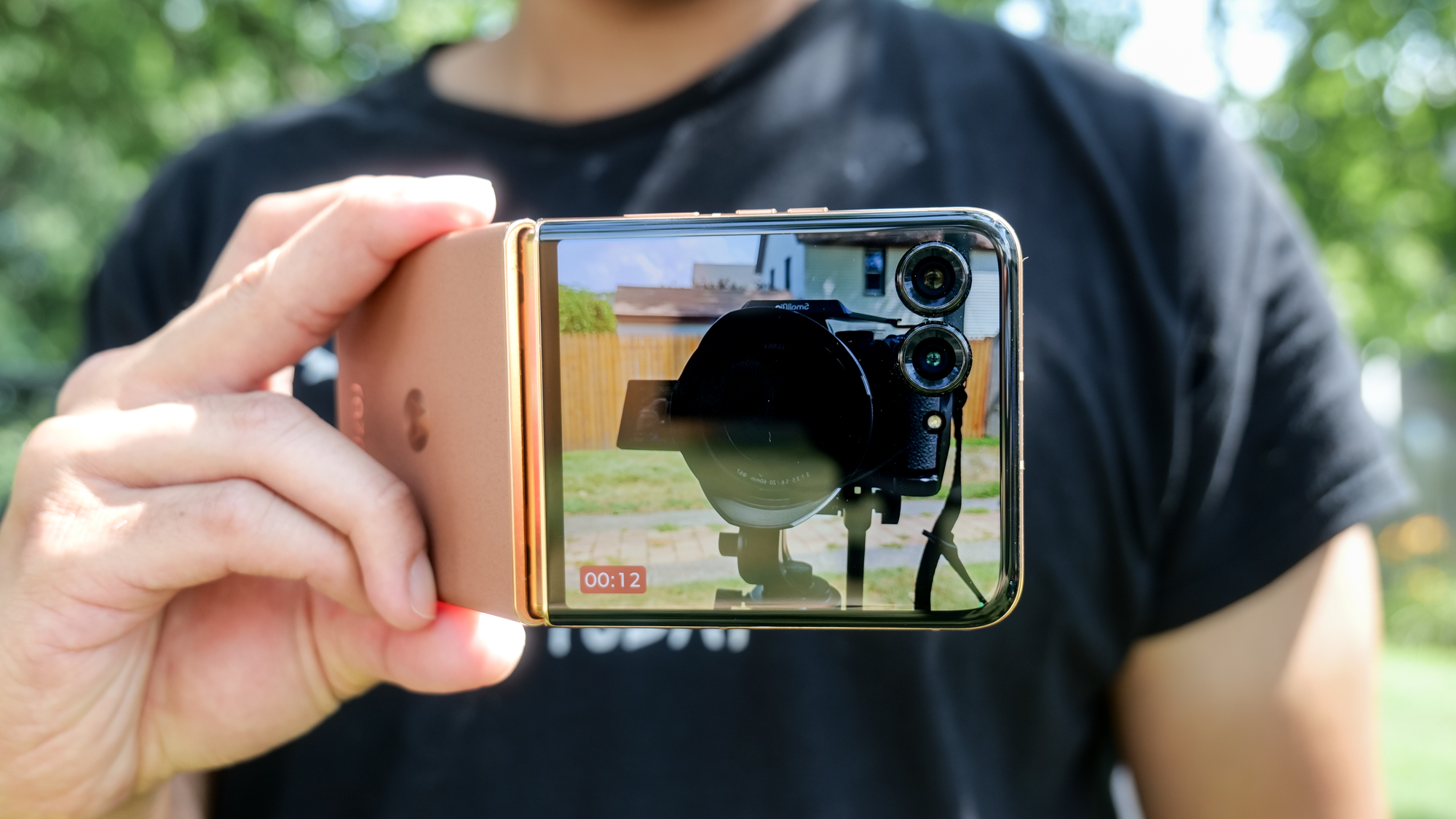
Motorola made a change that I said was controversial last year with the Razr Plus (2024). Instead of pairing an ultrawide camera with the main one, Moto ended up ditching the ultrawide in favor of a telephoto camera with optical zoom.
This is exactly what the company is offering again with the Razr Plus (2025), which packs a 50MP main camera with a 50MP telephoto with 2x optical zoom. Even though I prefer the Ultra’s set of cameras, the Plus still gets the same set of camera modes — made better when they’re paired with the outer screen.
Based on what I can see from the shot above with their main cameras, the Plus manages to replicate all the details from the Ultra. From the sharp details in the trees in the background and the street vendors, to how it balances the exposure between the highlights and shadows, I don’t see much of a difference.
Although the colors are very saturated with the produce shots above, the Razr Plus saturates the red peppers a lot more — making it look a bit exaggerated. I think the Ultra pulls off the better colors.
Due to how it lacks an ultrawide, the Plus can’t get as close to subjects for macro shots. You can still shoot closeups, but the Plus appears to overexpose the highlights of the flower and doesn’t have nearly as much definition as the Ultra’s shot.
Portrait shots are handled nicely by the Plus. In fact, it manages to apply that out of focus effect to the background — all while keeping sharp focus on me. When I zoom into my face, I really like how it captures the same level of detail with my facial features.
In the zoom department, the Razr Plus (2025) has an inherent advantage because of its 2x optical zoom — whereas the Razr Ultra (2025) relies on pixel binning techniques with its main shooter. At 2x zoom, it’s hard to distinguish this edge, but it becomes apparent at 10x and beyond. With the 30x zoom shots above, I can clearly make out the sharper details and definition of the tree branch with the Plus.
Shockingly, the Razr Plus (2025) pulls off the slightly better low light image above. The leaves and branches in the tree are slightly more exposed with the Plus, whereas those same areas are underexposed and dim with the Ultra. The reason for this despite the two foldables packing 50MP main cameras comes down to their apertures, with the Plus benefiting from a slightly wider f/1.7 aperture versus the Ultra’s f/1.8 one.
It’s really odd when a phone like the Plus rivals its more expensive sibling in the camera department. While I still prefer the Ultra’s pairing because of how its ultrawide camera is more suitable for what I capture, I can’t deny how the Plus’ cameras manage to pull off outstanding shots. It’s nearly a tie in most of the shots I captured, proving that its main camera is just as capable — while showing the edge it has in the zoom department.














Motorola Razr Plus (2025) review: Performance
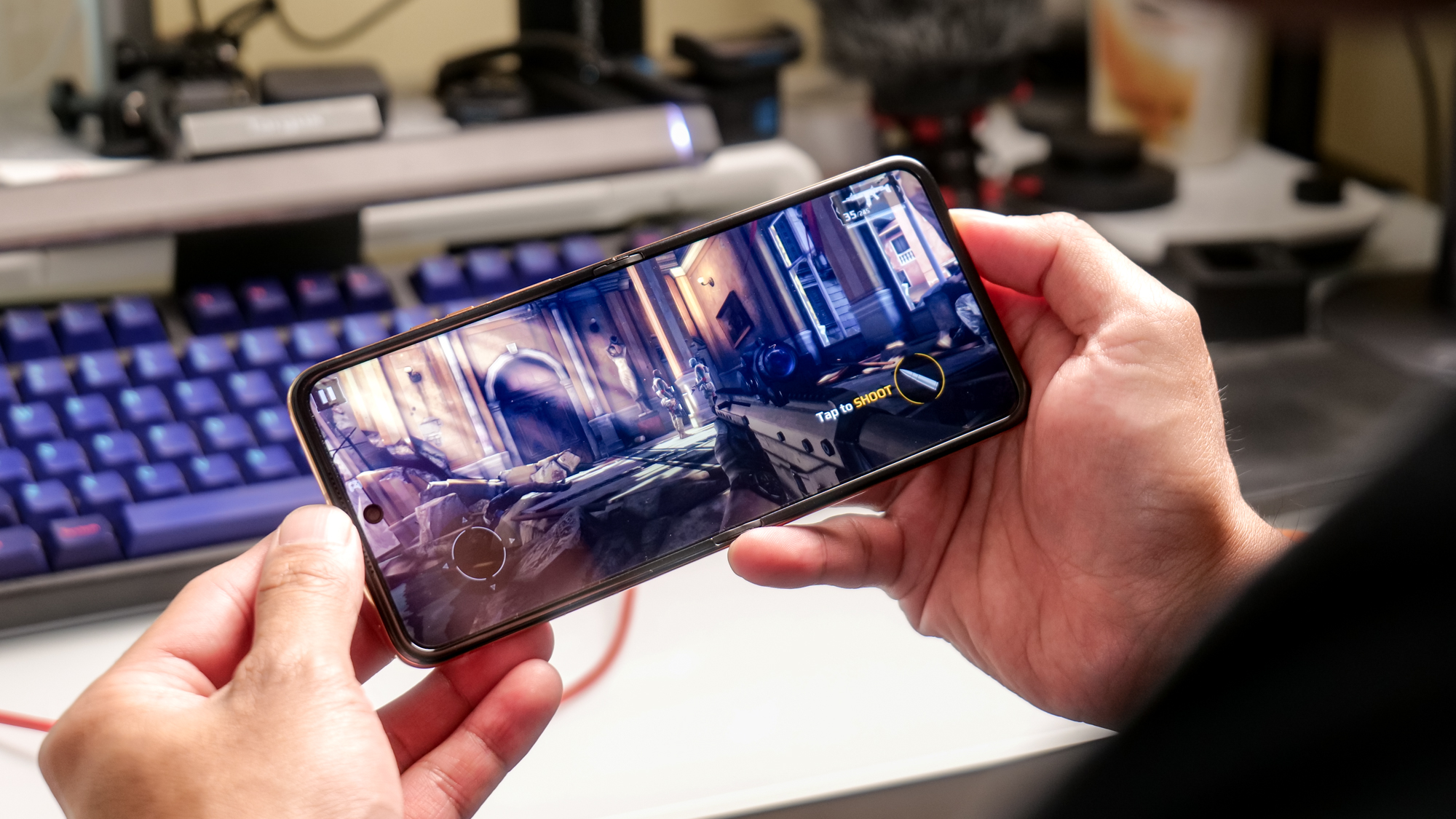
I expected Moto to upgrade the chipset in the Razr Plus (2025), but it didn't. Rather, the company recycles the same Snapdragon 8s Gen 3 SoC used by last year’s model — so there’s no performance boost whatsoever.
Both its single and multi-core scores in GeekBench 6 at 1,929 and 4,954 respectively aren’t worth bragging about, especially when there’s a significant difference against the Snapdragon 8 Elite with the Razr Ultra (2025). Even stranger is how it achieves a slightly lower frame rate of 71.16 fps running 3DMark’s Wild Life Unlimited test. That’s less than the 73.74 fps average last year’s Plus model averaged.
| Row 0 - Cell 0 | Motorola Razr Plus (2025) | Motorola Razr Ultra (2025) | Motorola Razr Plus (2024) |
Chipset | Snapdragon 8s Gen 3 | Snapdragon 8 Elite | Snapdragon 8s Gen 3 |
Geekbench 6 (single/multicore) | 1929 / 4954 | 2719 / 8342 | 1834 / 4848 |
3DMark Wild Life Unlimited (fps) | 71.16 | 145.32 | 73.74 |
Adobe Premiere Rush video transcode (Miins:Secs) | 1:01 | 0:59 | N/A |
Despite all of this, it’s a perfect example of how you can’t simply rely on synthetic benchmark tests. That’s because the Motorola Razr Plus (2025) still delivers the instant responses I want with just about everything. From scrolling through long web pages, to running some of the best photo editing apps I use on the daily, it never once feels sluggish or unresponsive — and that also includes gaming.
Motorola Razr Plus (2025) review: Battery

Battery life is an interesting area for the Razr Plus (2025) because of how Motorola kept the same battery capacity and chipset as before. There’s still a 4,000 mAh battery inside, which you’d suspect to achieve the same performance as last year’s model.
That’s not the case. After putting it through the same Tom's Guide battery benchmark test, it averaged around 12 hours and 45 minutes, which is short of the 13 hours and 25 minutes averaged by the Razr Plus (2024).
It's also worth that the Razr Ultra, which has a Snapdragon 8 Elite processor and larger 4,700 mAh battery, exceeds 15 hours with the same test.
It's a little strange that the battery is less than before, but it could be due to how the software is optimized given that the battery capacity, processor, and display are unchanged.
Average Battery life (Hrs:Mins) | Charging % in 15 minutes | Charging % in 30 minutes | |
Motorola Razr Plus (2025) | 12:45 | 19% | 41% |
Motorola Razr Ultra (2025) | 15:42 | 40% | 72% |
Motorola Razr Plus (2024) | 13:25 | 27% | 48% |
Power users will definitely need to recharge at some point during their day, but I’ve found it to at least last me through an 8-hour shift. Another strange revelation is how long it takes to charge, mainly because it features the same 45W wired speed as before. This time it gets to 40% after 15 minutes of charging, then onwards to 41% in 30 minutes. In comparison, the Razr Plus (2024) reached 27% and 48% respectively.
Motorola Razr Plus (2025) review: Software and AI
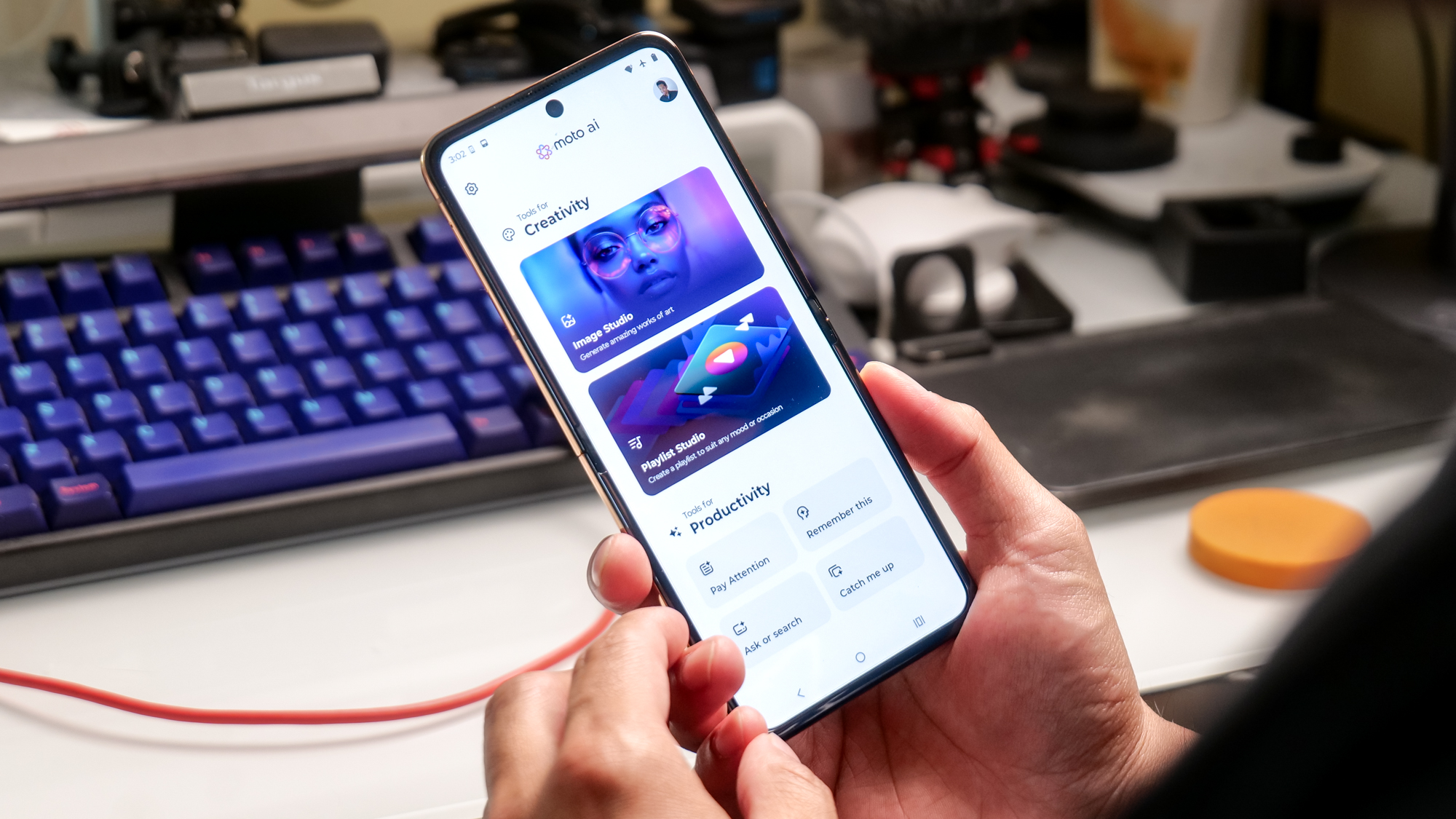
After teasing a few Moto AI features last year with the Razr Plus (2024), it’s nice to see them accessible from the get-go here with the Razr Plus (2025). It’s running Moto’s custom UI on top of Android 15, which I hope gets updated to Android 16 soon now it’s out.
Even with its new Moto AI features, it still trails what the Galaxy Z Flip 7 offers with its software package. However, I will give Motorola credit for really focusing more on AI-centric features this time. All of the Moto AI features are accessible through the corresponding Moto AI app, which consists of Image Studio, Catch Me Up, Remember This, Pay Attention, and much more.
Image Studio is similar to other image generators, like Image Playground on iPhone and Pixel Studio for Google’s phones. I tried generating one of my go-to prompts that involves mutant ninja black cats fighting turtles, but it doesn’t quite generate everything. I would say it’s on par to Image Playground, but nowhere to the degree of what Pixel Studio delivers.


Over on the productivity side, I’ve used the Pay Attention feature to record meetings — which then summarizes them for me. For the most part, it does it pretty well, but I would say Note Assist with Galaxy AI performs better. Other tools that make the Razr Plus (2025) capable include its ability to run two apps side-by-side, along with all the gesture support it’s known for, like being able to turn on the flashlight by performing a chopping gesture.
I also like Smart Connect on the Razr Plus (2025), which is sort of the company’s version of Samsung DeX. Essentially, I can get access to a desktop PC-like experience when I wirelessly connect to Miracast enabled devices. It’s a nice option to use if you want a larger screen to work with, but I wish it could do this all through a wired connection.

The software experience actually doesn’t differ from what the Razr Ultra (2025) offers, with the exception that there’s a dedicated button strictly to access some Moto AI features. But the rest remains the same, including the multimodal AI experience using Gemini Live with the camera. Meanwhile, the outer screen functions just as well for just about everything. From customizing the lock screen, to running full apps, I really enjoy the extra functionality.
Although it’s an improved experience, the software experience isn’t as robust as what you’d get in a Pixel or Galaxy device. It’s a first good step for Motorola when it comes to AI features, but it’s a long way away from what the competition delivers. Like the Razr Ultra (2025), you’re getting three years of software support with the Plus — which is a far cry from what Apple, Google, and Samsung gives its flagship models.
Motorola Razr Plus (2025) review: Verdict
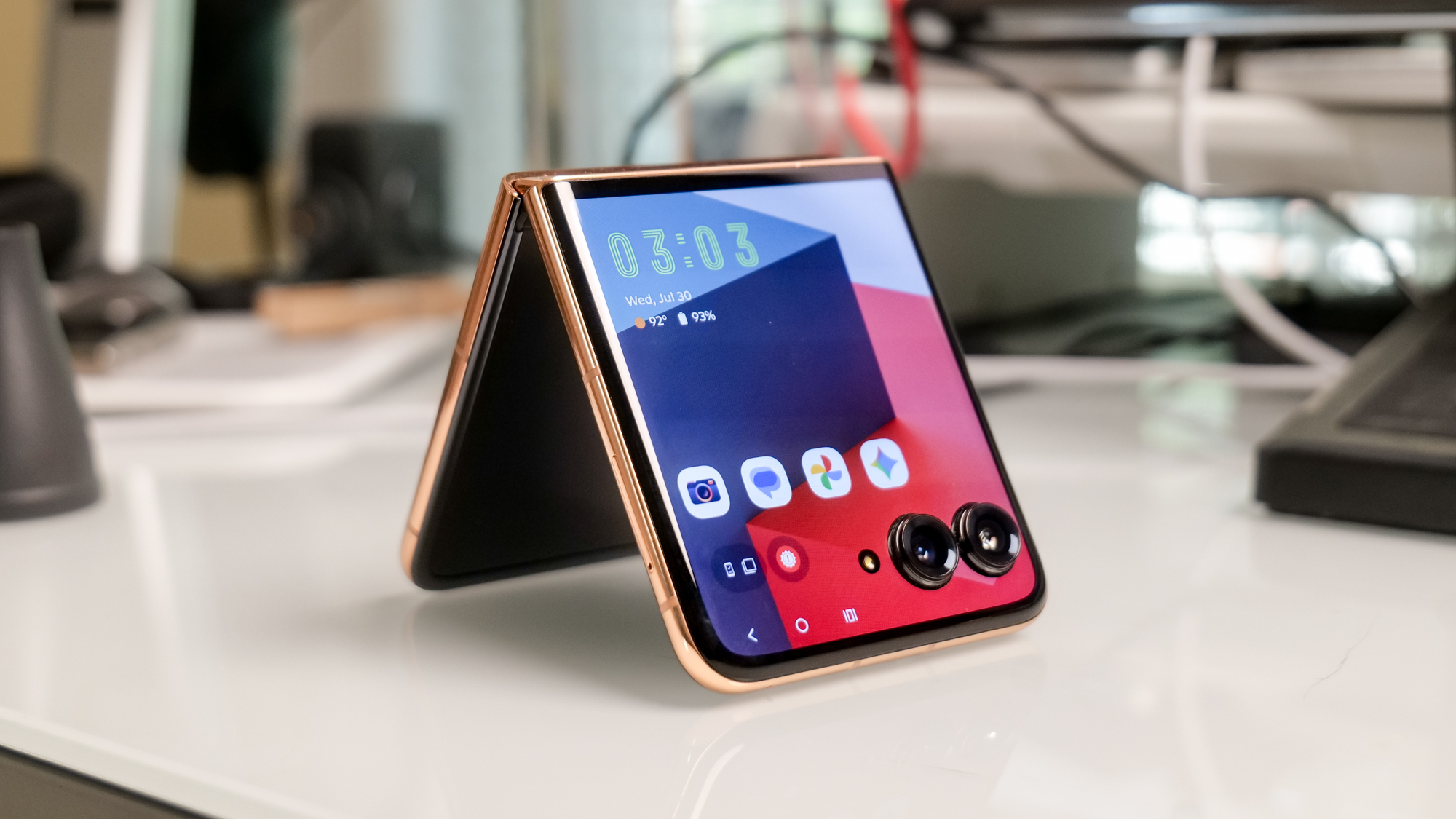
I didn’t realize it before, but now I don’t understand why the Motorola Razr Plus (2025) exists. Yes you’re saving $300 over the pricier Ultra, but it’s essentially the same exact phone as last year’s model — with worse battery life too.
Typically speaking, the newer model tends to get bigger hardware upgrades and a performance boost to convince people it’s worth getting. However, I can’t even make an argument for that because it’s packing the same processor, RAM, and battery size as before. The only meaningful addition centers around Moto AI, but that’s all.
Perhaps I’d think differently if it did get more hardware upgrades? Maybe. But the fact that it’s so similar to last year’s Plus, I can’t justify keeping the price at the same $999 cost as before.
Follow Tom's Guide on Google News to get our up-to-date news, how-tos, and reviews in your feeds. Make sure to click the Follow button.
More from Tom's Guide
- I put the Samsung Galaxy Z Fold 7 vs. Galaxy Z Fold 6 through a 10-round camera face-off — here's the winner
- Surprise! Samsung Galaxy Z Fold 7 found to be thinner than 'world's slimmest foldable'
- I just tried the new Samsung DeX on the Galaxy Z Flip 7 to replace my laptop — here's the good and the bad

John’s a senior editor covering phones for Tom’s Guide. He’s no stranger in this area having covered mobile phones and gadgets since 2008 when he started his career. On top of his editor duties, he’s a seasoned videographer being in front and behind the camera producing YouTube videos. Previously, he held editor roles with PhoneArena, Android Authority, Digital Trends, and SPY. Outside of tech, he enjoys producing mini documentaries and fun social clips for small businesses, enjoying the beach life at the Jersey Shore, and recently becoming a first time homeowner.
You must confirm your public display name before commenting
Please logout and then login again, you will then be prompted to enter your display name.


